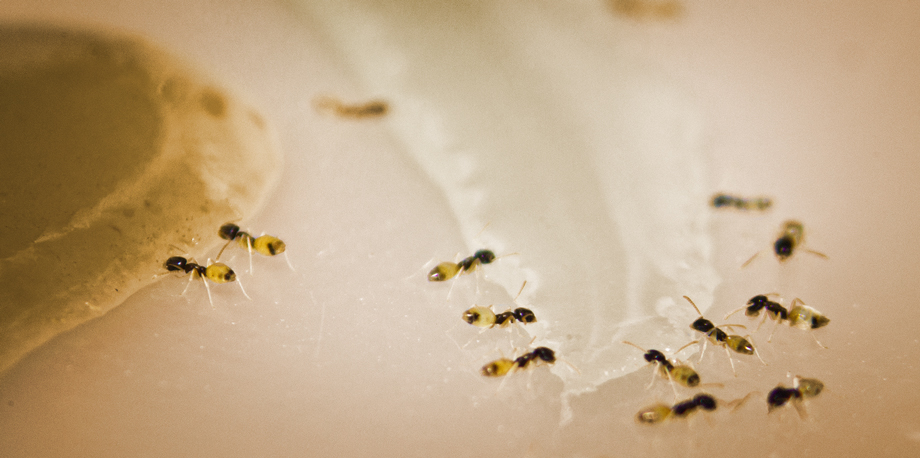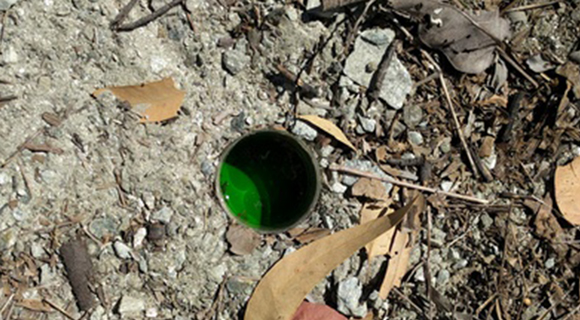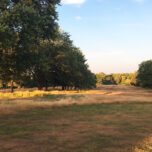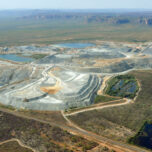February 5, 2019 — The ghost ant is aptly named. All six of its legs, not to mention the ant’s antennae and abdomen, sport a spectral yellow — a pale hue that often fades into the background, leaving the ant’s tiny brown head and torso to bob along, barely visible, like a spirit in the breeze.
Except the ghost ant is hardly a heavenly specter. It’s an earth-bound creature common across much of the globe, adapted so well to human habitats that it’s seen as a pest.
In an abandoned field in Brazil, many ghost ants have made their home. A team of biologists, there as part of research on how old farmland for sugarcane — a tropical grass used to make sugar, rum and ethanol fuel — has recovered once it’s reforested with native plants, spotted these insects, and other ant species. In the plot, retired from sugarcane production just five years earlier, common denizens included ghost ants and fungus-farming Atta species, both of which also live in cities.
The presence of these ants in that field tells scientists one part of a story about how the area’s environment is recovering from intensive agriculture. As stakeholders around the world look to rehabilitate ecosystems damaged by farming, mining and other activities, scientists are turning to ants — which play pivotal roles in most environments — to see exactly how effective restoration efforts are.
Telling Ecological Secrets
Ants make good ecosystem indicators because they interact with many other species — for example by eating spiders or making nests that double as homes for microorganisms — and influence important processes like nutrient cycling and seed dispersal. They live just about everywhere except the polar regions.
And their numbers are staggering. If you found a sufficiently large scale and weighed all the animals on Earth, ants would account for between 15 and 20 percent of that total biomass.
Like other insects, ants reproduce quickly, cycling through generation after generation much faster than do mammals and other vertebrates. “Ants in general respond quite easily to changes in their environment, and in that sense they can be used as indicators for many other species groups as well,” says Pekka Punttila, a senior researcher at the Finnish Environment Institute.
In Brazil, the team that observed ghost ants published their findings in a study a little over a year ago. To learn more about projects to revitalize landscapes altered by sugarcane production, the researchers identified four plots of land: abandoned fields that had been reforested with native plant species five, ten, and twenty years prior, plus an undisturbed section of forest.
Then they had to catch ants. For that task, the team used pitfall traps. The traps are simple: small containers, about 2.4 inches (6 centimeters) in diameter, filled with water and detergent placed in the ground with the rim level with the surface. Ants of all sizes get caught by falling in. The other sampling method involved removing sections of soil.
Back in the lab, the scientists sorted through their finds and identified the genus of every ant specimen.
After running the numbers, the team found that each fragment of land supported ant communities that looked quite different. In the field reforested just five years prior, the most common ants were species also routine in urban areas.
In the areas left to nature for longer, especially the site undisturbed for 20 years, different ants proved dominant, for example the wood- and twig-nesting Pachycondyla. In the oldest native forest, one important genus was Crematogaster, composed of tree-dwelling predator ants.
As restoration plods on, the living things that settle an area alter its soil, its food sources, its entire environment, creating conditions that open the door for new species to take their place. Those new species revamp the ecosystem again, continuing the cycle of change biologists call ecological succession, a phenomenon most studied in plants. What’s striking about the Brazil study is how clearly this change over time held for ants.
“Seeing this process occurring also with ants, seeing the succession theory working with animals, is very interesting,” says Daniel de Paiva Silva, an ecologist at Brazil’s Goiano Federal Institute of Education, Science and Technology who contributed to the research.
The study also analyzed what these various ant groups indicated about their environments, finding a strong association between ants and environmental attributes such as the humidity of leaf litter on the ground.
Key Indicators
A 2009 study found that ants are more diverse across the Southern Hemisphere, in places like Brazil, than they are north of the equator. It’s no surprise, then, that the hotspot for research using ants to gauge ecosystems lies in the southern latitudes: Australia.
Home to many ant species, Australia is also home to a massive mining industry, which means thousands of retired or ready-to-retire mines. At some of these sites, ants are helping guide ecological restoration.
Take the Ranger uranium mine. After more than three decades of operation by the Darwin-based Energy Resources of Australia Ltd. (ERA), the Ranger mine — located on land traditionally owned by the Mirarr Aboriginal people — ended uranium extraction in 2012, leaving workers to process what’s left of the ore stockpiles.
Now the hard part begins. The Ranger site sits within the World Heritage–listed Kakadu National Park, and government regulations require ERA to rehabilitate the mine area — an important priority for the Mirarr people, too.
“The goal of the rehabilitation is to produce ecosystems similar to that surrounding park, so the land can be incorporated into the park,” says Alan Andersen, a professorial fellow at the Research Institute for the Environment and Livelihoods at Charles Darwin University in Darwin, Australia. He’s been tasked with establishing criteria to determine when ERA has met its obligations.
Setting standards for when the Ranger site can be absorbed into Kakadu means addressing a key issue: How can researchers measure whether two areas have similar ecosystems? Andersen’s answer is ants. With his team, he ventures into Kakadu to discover which of the small social insects live in the area — knowledge he’s using to write guidelines for how officials should assess the ecological restoration back at the mine site.
By surveying what kinds of ants inhabit recovering biomes, and how common each species is, scientists can assess the success of tactics used to re-establish ecological communities.
This entails catching ants by the tens of thousands, which he does using pitfall traps, just like the Brazilian research team. Though Andersen’s traps are a bit smaller, they’re the same sort of setup: small containers dug into the ground.
“And you sort of think … ‘Who would just walk past and drop in?’ But you will be amazed,” Andersen says. He once collected 27 different ant species in a single trap over just two days.
Back in the lab, Andersen and his team pour their collected ants onto a tray, sort them by species and tally the numbers. This process tells him about ant communities in Kakadu, and thus what ant communities at the Ranger site should look like once the area has been rehabilitated.
Back to the Beginning
This research stretches back decades in Australia. The story starts with Jonathan Majer, a recently retired Curtin University conservation professor whom Andersen describes as the father of using ants as indicators for ecosystem health.
In the 1970s, a young Majer — newly granted doctoral degree in hand — approached Alcoa, a Pittsburgh, Pennsylvania-based multinational that mined (and still mines) bauxite, the ore processed to make aluminum, in Western Australia. He says he told Alcoa he wanted to inspect revegetation efforts at some of the company’s retired mine pits to see how ants and other invertebrates related to ecological restoration.
After Majer wrote a report on his observations, he partnered with Alcoa to study dozens more sites and publish a scientific paper looking at what factors encouraged ants to repopulate rehabilitated mines. “We wrote this up, and then it occurred to me … perhaps you could turn this around and look at the ant fauna as an indication of all these environmental conditions that they respond to,” he says. “In other words, ask the ants, ‘How well is the revegetation going?’”
The immense variety of ants means a detailed sketch of the environment.
By surveying what kinds of ants inhabit recovering biomes, and how common each species is, scientists can assess the success of tactics used to re-establish ecological communities.
The idea aimed to make assessments of rehabilitation more rigorous. Routine approaches, Majer says, assumed that restoring plant life to an area equaled success. But simply planting an area with lush greenery isn’t necessarily enough to entice the diverse crowd of insects and other invertebrates that a functioning ecosystem needs.
The immense variety of ants means a detailed sketch of the environment. “Some ants [are] cryptic species that require a thick, moist leaf litter layer,” Majer explains. “Some ants require good sunlight to warm their nest up. Some ants are nesting in twigs or tree trunks. Some nest in the soil, and some nest in shaded soil, some nest in sunny soil.”
Over the ensuing years, Majer has kept this work going — and going global. Ants have taught him about the status of ecosystems in Australia, but also in Brazil and South Africa. He even founded BioMonitoring International, a consulting company that employs many of the techniques he developed.
A Crucial Conversation
Where these techniques have seen less application is north of the equator, where fewer ants live. But the Northern Hemisphere isn’t totally devoid of scientists who’ve chronicled ant life to learn more about ecosystems.
In southern Finland, people engaged in farming and forestry have drained nearly 80 percent of peatlands, swampy environments marked by partially decomposed plant matter. Dozens of Finnish species associated with these boggy mires have become more threatened, even as scientists increasingly realize the importance of such environments worldwide for storing carbon dioxide and thus mitigating climate change.
Metsähallitus, the organization that manages land and water areas owned by the Finnish government, aims to address the problem by filling ditches and removing trees, with the goal of recreating the sparse pine stands that mark Finland’s natural mire habitats.
To get an idea of whether this restoration strategy works, Pekka Punttila partnered with a team of other scientists. They analyzed both plants and ants in pristine, drained and recently restored mires. Even though ants are less numerous in colder, more northern regions like Finland, at least a third of the country’s 55 native ant species count mires as crucial habitat.
The team published their findings in a 2016 journal article. After sampling ants with pitfall traps, the researchers found that mires restored a mere one to three years prior had already attracted many new species. “This surprisingly rapid reaction by the ants is the most important message in our paper,” Punttila says.
Since the study tracked mire ants for just three years, Punttila cautions, future research should include longer term monitoring. It’s a point echoed by Andersen in Australia. A clear picture of what ants look like in Kakadu National Park will set the benchmark Alcoa, the mining company, must meet before the Ranger site can be incorporated into the park, but achieving those goals will likely prove difficult. The restoration, after all, is starting with bare rock. “How long is it going to take to be successful?” Andersen asks. “A long time.”
Related Posts
Ensia shares solutions-focused stories free of charge through our online magazine and partner media. That means audiences around the world have ready access to stories that can — and do — help them shape a better future. If you value our work, please show your support today.
Yes, I'll support Ensia!




